Study on Evolution of the Thermophysical and Mechanical Properties of Inner Shaft Lining Concrete during Construction Period
Abstract
:1. Introduction
2. Materials and Method
2.1. Engineering Background
2.2. Experimental Method and Process
2.2.1. Simulation Model of Newly Poured Shaft Lining
2.2.2. Experimental Parameters and Measurement Methods
3. Results and Discussion
3.1. Evolution of Temperature Field
3.2. Evolution of Thermophysical Properties
3.2.1. Thermal Conductivity
3.2.2. Specific Heat Capacity
3.3. Evolution of Mechanical Properties
3.3.1. Compressive Strength
3.3.2. Tensile Strength
3.3.3. Elastic Modulus
4. Conclusions
- (1)
- The evolution of temperature in an inner shaft lining within the first 7 d after pouring can be divided into five stages: induction, slow heating, rapid heating, rapid cooling, and slow cooling. The maximum temperature of the inner shaft lining concrete gradually increases with the lining thickness and can reach 76.5 °C when the thickness is 1.5 m. The maximum temperature in the shaft lining is not always at the center in the radial direction but gradually moves outward with the increase of thickness.
- (2)
- The thermal conductivity of inner shaft lining concrete decreases significantly with an increase in age. Simultaneously, the thermal conductivity of the inner shaft lining concrete increases with the lining thickness. The thermal conductivity of the inner shaft lining concrete with thicknesses of 1.0, 1.2, and 1.5 m evolves between 0.92 and 2.16 W/(m·k) within the first 7 d after pouring.
- (3)
- The specific heat capacity of shaft lining concrete decreases significantly with an increase in age, and the decline rate gradually decreases with an increase in age. The specific heat capacity of material at the same age increases significantly with an increase in thickness. The specific heat capacity of the inner shaft lining concrete at thicknesses of 1.0, 1.2, and 1.5 m evolves between 0.66 and 0.98 KJ/(kg·k) within the first 7 d after pouring.
- (4)
- The compressive strength of the shaft lining concrete increased significantly with an increase in age within the first 7 d after pouring, and the increase rate gradually decreased with an increase in age. The compressive strength at the same age increases significantly with the thickness, and the increase rate has no apparent association with the thickness. The compressive strength of the inner shaft lining concrete with thicknesses of 1.0, 1.2, and 1.5 m evolves between 37.33 and 57.01 MPa within the first 7 d after pouring.
- (5)
- The tensile strength of shaft lining concrete significantly increases with age, and the increase rate gradually decreases with an increase in age. The tensile strength of the shaft lining concrete at the same age increases gradually with the thickness, but the increase rate has no apparent association with the thickness. The tensile strength of the inner shaft lining concrete with thicknesses of 1.0, 1.2, and 1.5 m evolves between 2.86 and 3.96 MPa within the first 7 d after pouring.
- (6)
- The elastic modulus of the shaft lining concrete significantly increases in the first three days and increases slightly in the later ages. The inner shaft lining thickness can accelerate the entry of the elastic modulus to the stable state. The elastic modulus of inner shaft lining concrete at the same age increases significantly with the thickness. The elastic modulus of the inner shaft lining concrete with thicknesses of 1.0, 1.2, 1.5 m evolved between 3.17 × 104 MPa and 3.56 × 104 MPa within the first 7 d after pouring.
Author Contributions
Funding
Institutional Review Board Statement
Informed Consent Statement
Data Availability Statement
Conflicts of Interest
References
- Yang, Y.; Liao, M.; Cai, H. Numerical simulation of the temperature fields in the shielding walls of frozen soil with multi-circle-pipe freezing in shaft sinking. Therm. Sci. 2019, 23, 647–652. [Google Scholar] [CrossRef] [Green Version]
- Fu, Y.; Hu, J.; Wu, Y. Finite element study on temperature field of subway connection aisle construction via artificial ground freezing method. Cold Reg. Sci. Technol. 2021, 189, 103327. [Google Scholar] [CrossRef]
- Zhu, H.; Han, L. Experimental study on grouting seepage characteristics of single-fracture specimen under three-dimensional stress. Arab. J. Geosci. 2022, 15, 840. [Google Scholar] [CrossRef]
- Ding, N.; Hu, C.L.; Yu, J.C.; Liu, Y.N. Application of distributed fiber-optic temperature sensor in shaft-sinking by freezing in coal mine. Transducer Microsyst. Technol. 2014, 33, 154–160. [Google Scholar]
- Wang, B.S.; Sun, P.X.; Luo, T.T.; Tao, Z. Freezing Pressurized Water into a Standard Cylindrical Ice Sample in a Triaxial Cell. Geofluids 2021, 2021, 6678966. [Google Scholar] [CrossRef]
- Yang, W.H. The development and Prospect of freezing drilling technology in China in the past ten years. In Proceedings of the High Level Academic Forum on the 50th Anniversary of the Founding of China Coal Society, Beijing, China, 2012. [Google Scholar]
- Cheng, H.; Cai, H.B. Safety Situation and Thinking about Deep Shaft Construction with Freezing Method in China. J. Anhui Univ. Sci. Technol. 2013, 33, 1–6. [Google Scholar]
- Yao, Z.S.; Cheng, H.; Zhang, G.Y. Research on site measurement of outer shaft wall stressing in freezing sinking shaft in special thick alluvium. Coal Sci. Technol. 2004, 32, 49–52. [Google Scholar]
- Wang, Y.S. Study on the Law of Strength Growth, Stress and Deformation of the Outer Wall of Freezing Shaft Lining in Extra Thick Alluvium; China University of Mining and Technology: Xuzhou, China, 2005. [Google Scholar]
- Deng, W.G.; Shen, J.H.; Qiao, G.L. Summary and Thinking on the existence of coal mine well construction in Western China. Mine Const Ruction Technol. 2010, 31, 29–33. [Google Scholar]
- Chen, J.T. Meso-Numerical Calculation of Crack Mechanism of Concrete on Inner Wall of Deep and Large Frozen Shaft During Sinking Period; China University of Mining and Technology: Xuzhou, China, 2021. [Google Scholar]
- Mao, J.H. Prediction and Evaluation of Coal Resources in China; Science Press: Beijing, China, 1999. [Google Scholar]
- Ranjith, P.G.; Zhao, J.; Ju, M.H.; Rathnaweera, T.D. Opportunities and Challenges in Deep Mining: A Brief Review. Engineering 2017, 3, 546–551. [Google Scholar] [CrossRef]
- Kijko, A. An Introduction to Mining Seismology; Academic Press: San Diego, CA, USA, 1994. [Google Scholar]
- Chen, B.; Zhang, S.; Li, Y.; Li, Z.; Zhou, H. Physical simulation study of crack propagation and instability information discrimination of rock-like materials with faults. Arab. J. Geosci. 2020, 13, 966. [Google Scholar] [CrossRef]
- Wang, T.; Zhang, H.; Zhou, G.Q.; Liu, X.Y. Evaluation of variability characteristics of mechanical parameters of artificially frozen clay in deep alluvium. Cold Reg. Sci. Technol. 2020, 171, 102978. [Google Scholar] [CrossRef]
- Zhang, J.; Zhang, X.; Guo, X. Water in rush Analysis and Manage Measures of Shaft Sinking by Freezing Method. Disaster Adv. 2012, 5, 452–456. [Google Scholar]
- Chen, X.S. A Space-Time-Dependant Design Method and the Stability of Ice Wall for Deep Shafts. Appl. Mech. Mater. 2012, 204, 3275–3281. [Google Scholar] [CrossRef]
- Zhang, C.; Zhang, Y.; Yang, W.H.; Li, H.P.; Lu, Q. Study on Temperature Field Evolution and Frozen Wall Closure Judgment Criteria of Inclined Shaft under Inclined Holes Freezing Condition. Geofluids 2022, 2022, 8002667. [Google Scholar] [CrossRef]
- Hu, J.; Wang, X.; Jiang, B. Numerical Analysis of Temperature Field of Vertical Frozen Soil Wall Reinforcement at Shield Shaft. In Proceedings of the 2014 3rd International Conference on Micro Nano Devices, Structure and Computing Systems, Singapore, 1–2 March 2014. [Google Scholar]
- Wang, Y.S.; Yang, R. Monitoring and analysis of the stress and deformation of shaft lining and the influence of freezing tube fracture in deep topsoil. Cold Reg. Sci. Technol. 2022, 193, 103420. [Google Scholar] [CrossRef]
- Yu, G.C. The prevention of cracking and water leakage in the concrete inner lining of frozen shafts. Int. J. Min. Geol. Eng. 1986, 4, 247–251. [Google Scholar]
- Meddah, M.S.; Suzuki, M.; Sato, R. Influence of a combination of expansive and shrinkage-reducing admixture on autogenous deformation and self-stress of silica fume high-performance concrete. Constr. Build. Mater. 2011, 25, 239–250. [Google Scholar] [CrossRef]
- Jiang, X.P.; Wang, S.L.; Yong, Y.L. Research on Controlling Mechanism of Temperature Crack of High Performance Concrete on Freezing Shaft Lining in Special Thick Alluvium. Adv. Mater. Res. 2012, 368, 1300–1306. [Google Scholar] [CrossRef]
- Jzab, C.; Fl, B.; Slab, C. Early age cracking potential of inner lining of coal mine frozen shaft. Energy Rep. 2022, 8, 16–24. [Google Scholar]
- Neji, M.; Barbe, F.B.; Imbert, C. Data-Based Modeling of Early-Age Concrete Mechanical Behavior for Structural Calculation. J. Mater. Civ. Eng. 2020, 32, 04019370. [Google Scholar] [CrossRef]
- Gamnitzer, P.; Drexel, M.; Brugger, A. Calibration of a Multiphase Model Based on a Comprehensive Data Set for a Normal Strength Concrete. Materials 2019, 12, 791. [Google Scholar] [CrossRef] [PubMed] [Green Version]
- Wang, X.S.; Cheng, H.; Wu, T.L.; Yao, Z.S.; Huang, X.W. Numerical Analysis of a Novel Shaft Lining Structure in Coal Mines Consisting of Hybrid-Fiber-Reinforced Concrete. Crystals 2020, 10, 928. [Google Scholar] [CrossRef]
- Jendrys, M. Analysis of stress state in mine shaft lining, taking into account superficial defects. IOP Conf. Ser. Earth Environ. Sci. 2019, 261, 012016. [Google Scholar] [CrossRef]
- Kahouadji, A.; Clastres, P.; Debicki, G. Early-age compressive strength prediction of concrete—Application on a construction site. Constr. Build. Mater. 1997, 11, 431–436. [Google Scholar] [CrossRef]
- Dong, W.; Zhou, X.; Wu, Z. A fracture mechanics-based method for prediction of cracking of circular and elliptical concrete rings under restrained shrinkage. Eng. Fract. Mech. 2014, 131, 687–701. [Google Scholar] [CrossRef] [Green Version]
- Kim, J.K.; Sang, H.H.; Park, S.K. Effect of temperature and aging on the mechanical properties of concrete. Cem. Concr. Res. 2002, 32, 1095–1100. [Google Scholar] [CrossRef]
- Deng, Z.C.; Mei, Y.J.; Yang, Z.F.; Chen, J.; Xin, Z.H. Study on Influence of Different Factors on Thermal Conductivity of Ceramite Concrete. Sichuan Build. Material. 2020, 46, 8–9. [Google Scholar]
- Zhang, W.P.; Tong, F.; Xing, Y.S.; Gu, X.L. Experimental Study and Prediction Model of Thermal Conductivity of Concrete. J. Build. Mater. 2015, 18, 183–189. [Google Scholar]
- Zhang, F. Experimental Study on Thermal Parameters of Concrete; Tongji University: Shanghai, China, 2019. [Google Scholar]
- Hammons, M.I.; Smith, D.M. Early-Time Strength and Elastic Modulus of Concrete with High Proportions of Fly Ash. In Serviceability & Durability of Construction Materials; ASCE: New York, NY, USA, 2015. [Google Scholar]
- Whiting, D.A.; Detwiler, R.J.; Lagergren, E.S. Cracking Tendency and Drying Shrinkage of Silica Fume Concrete for Bridge Deck Applications. Aci Mater. J. 2000, 91, 71–77. [Google Scholar]
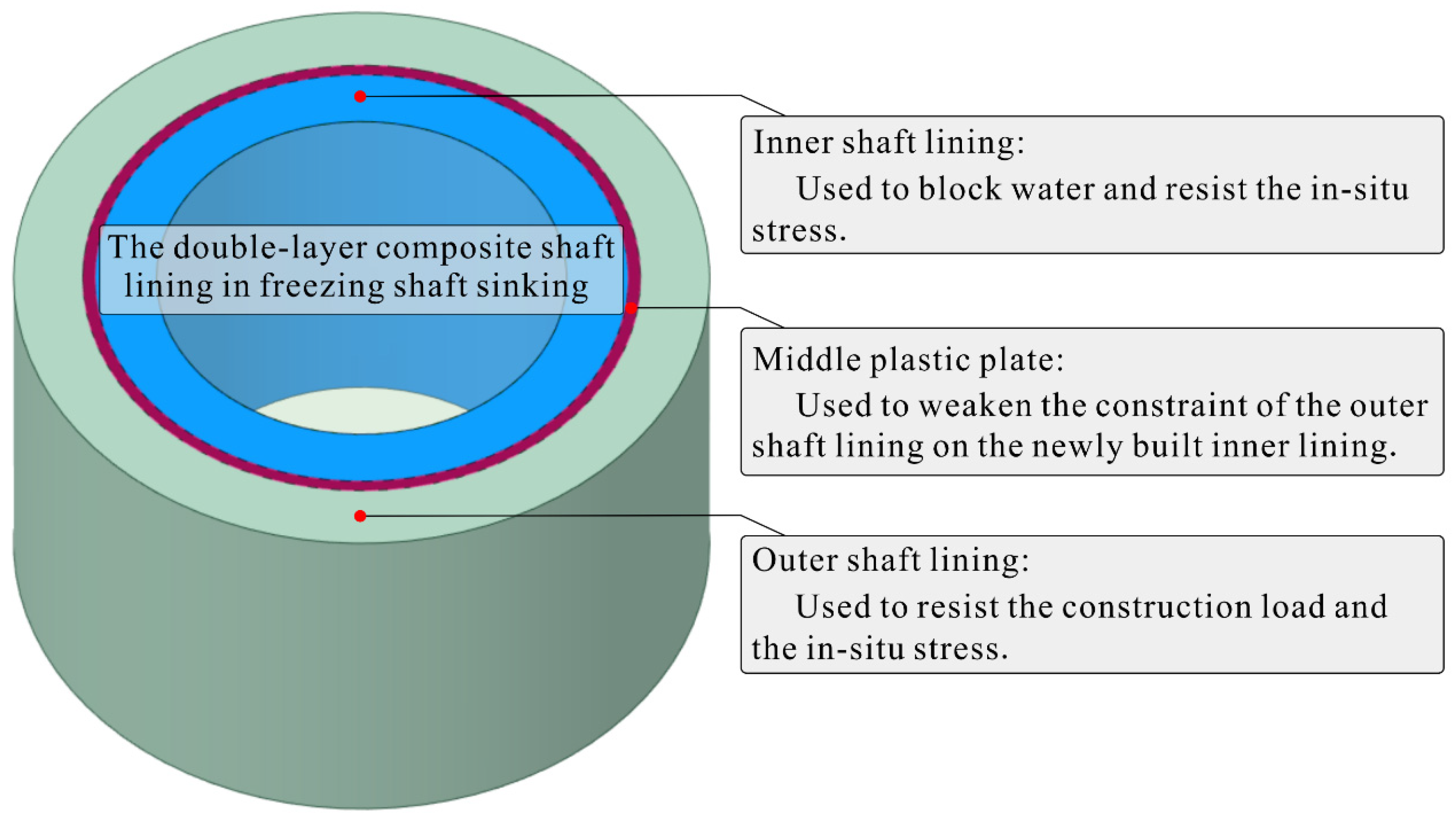
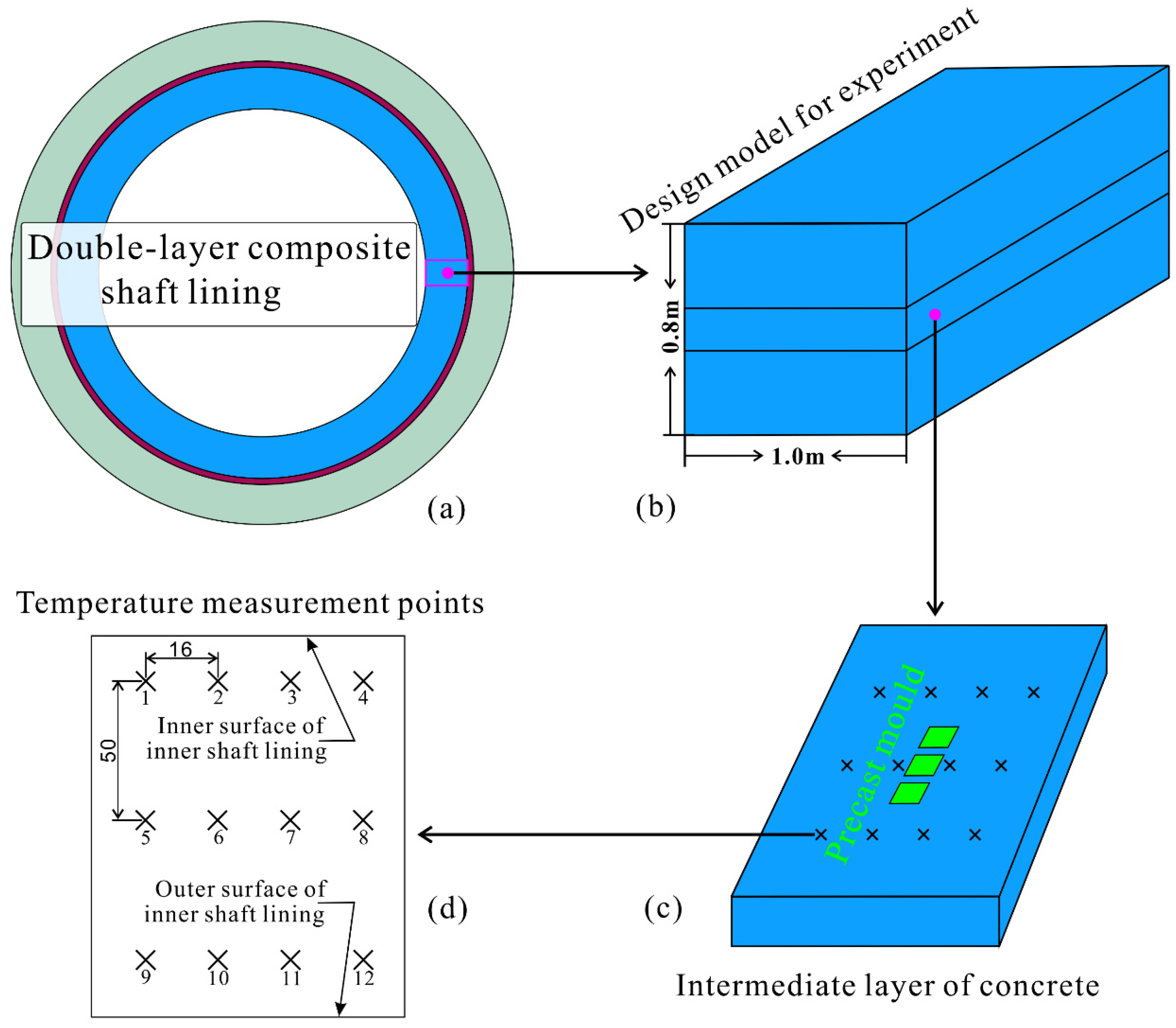
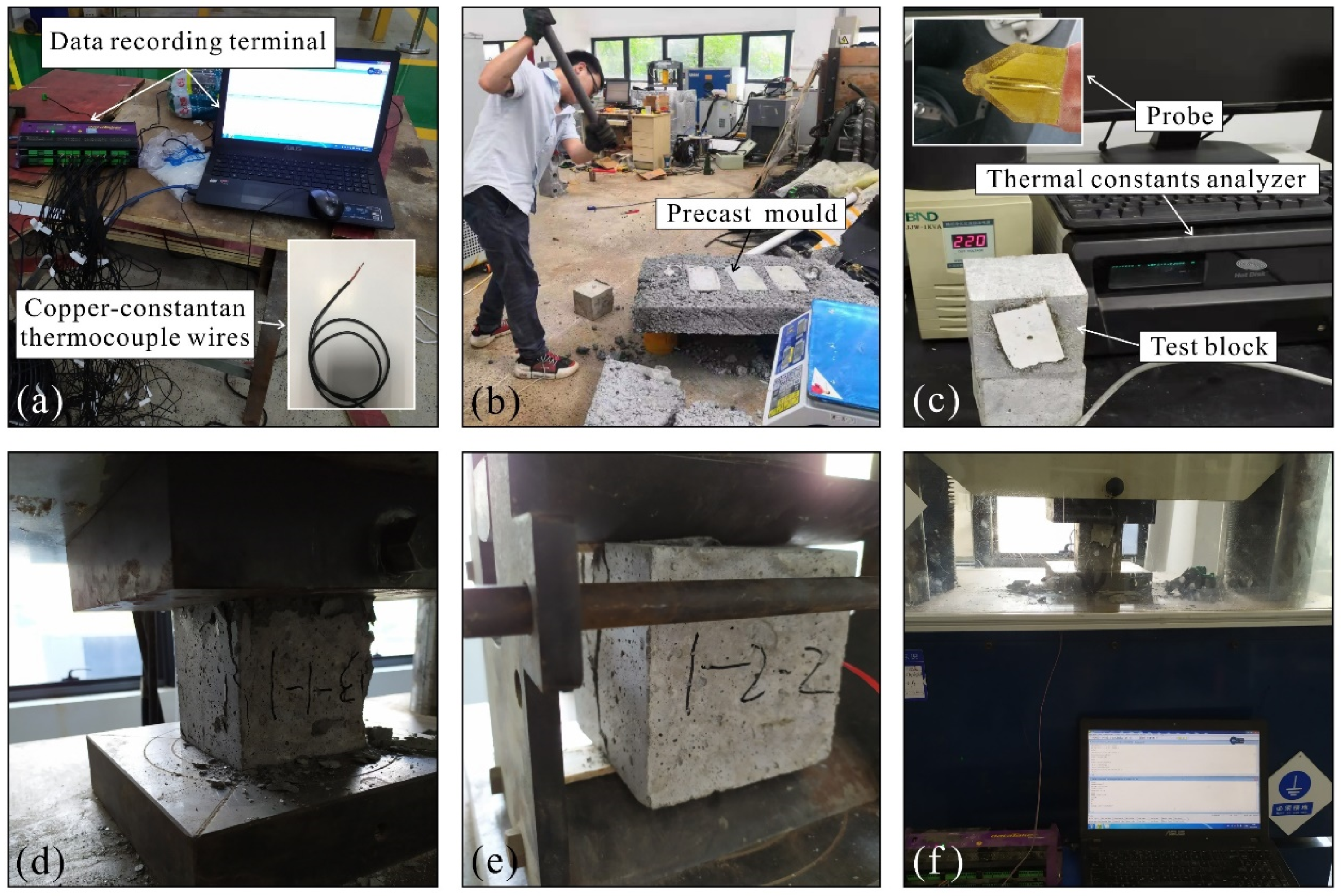
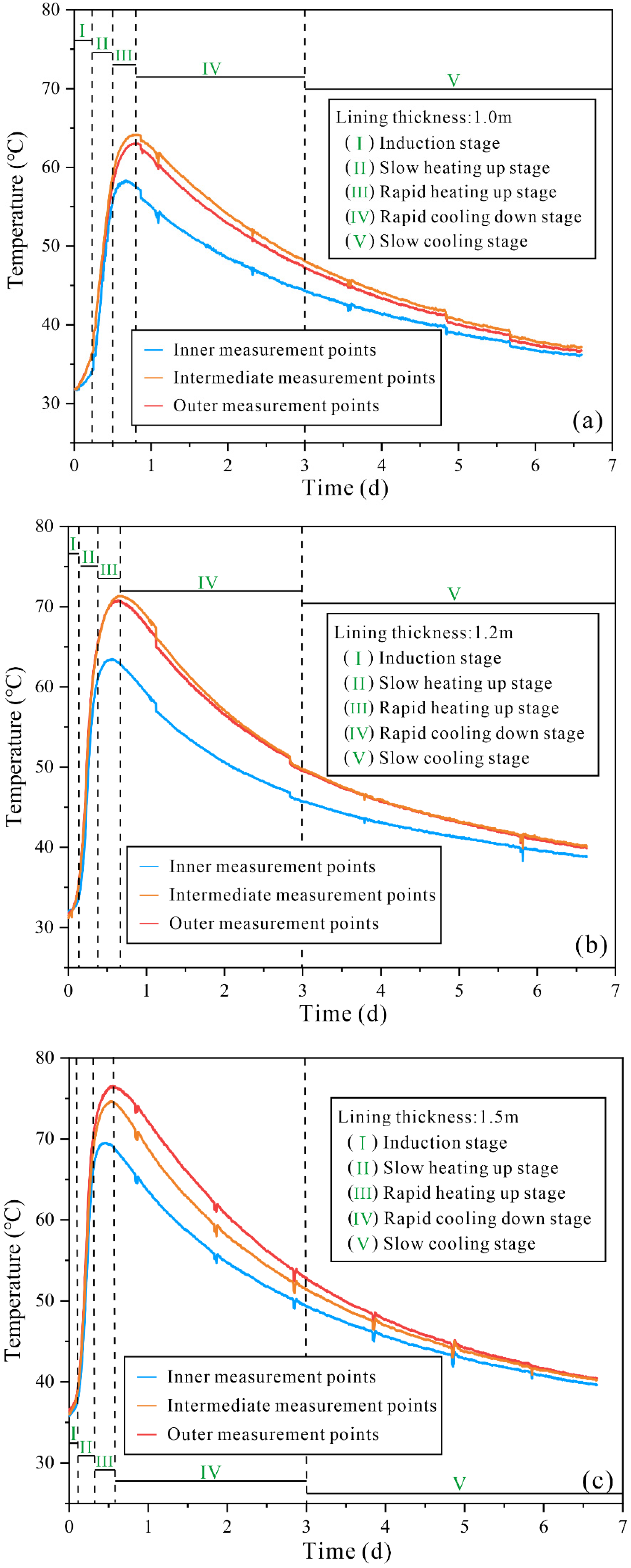
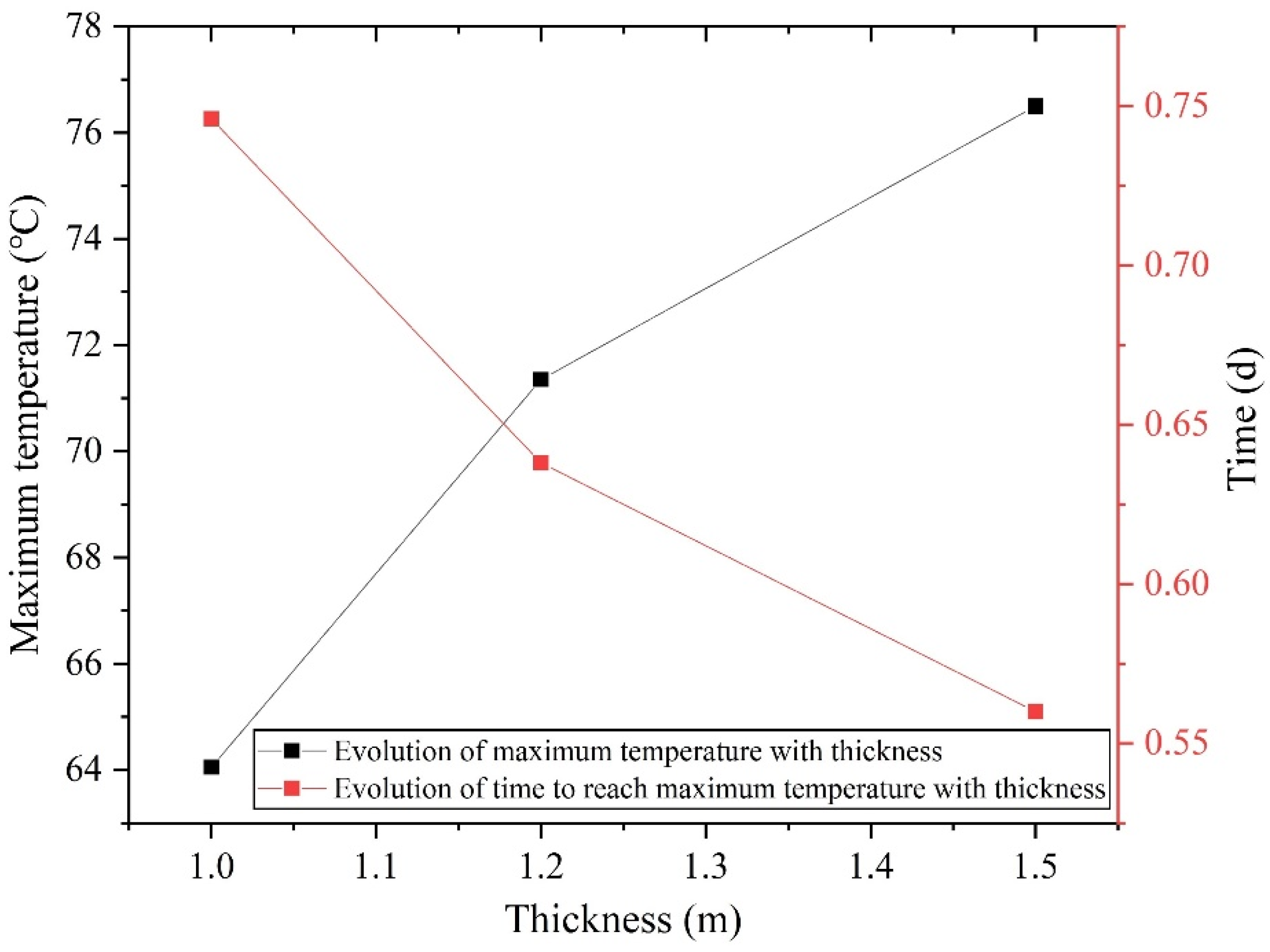
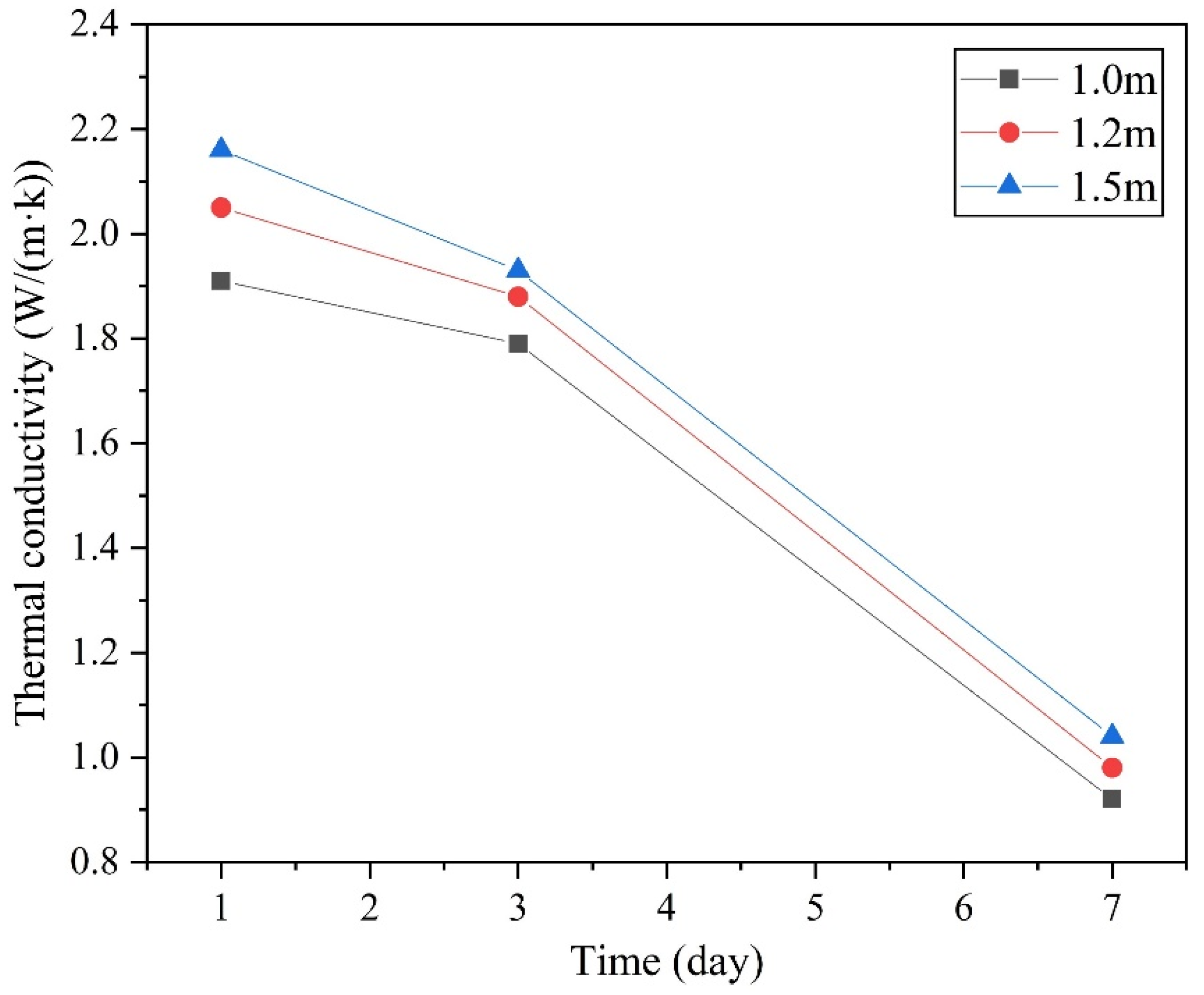
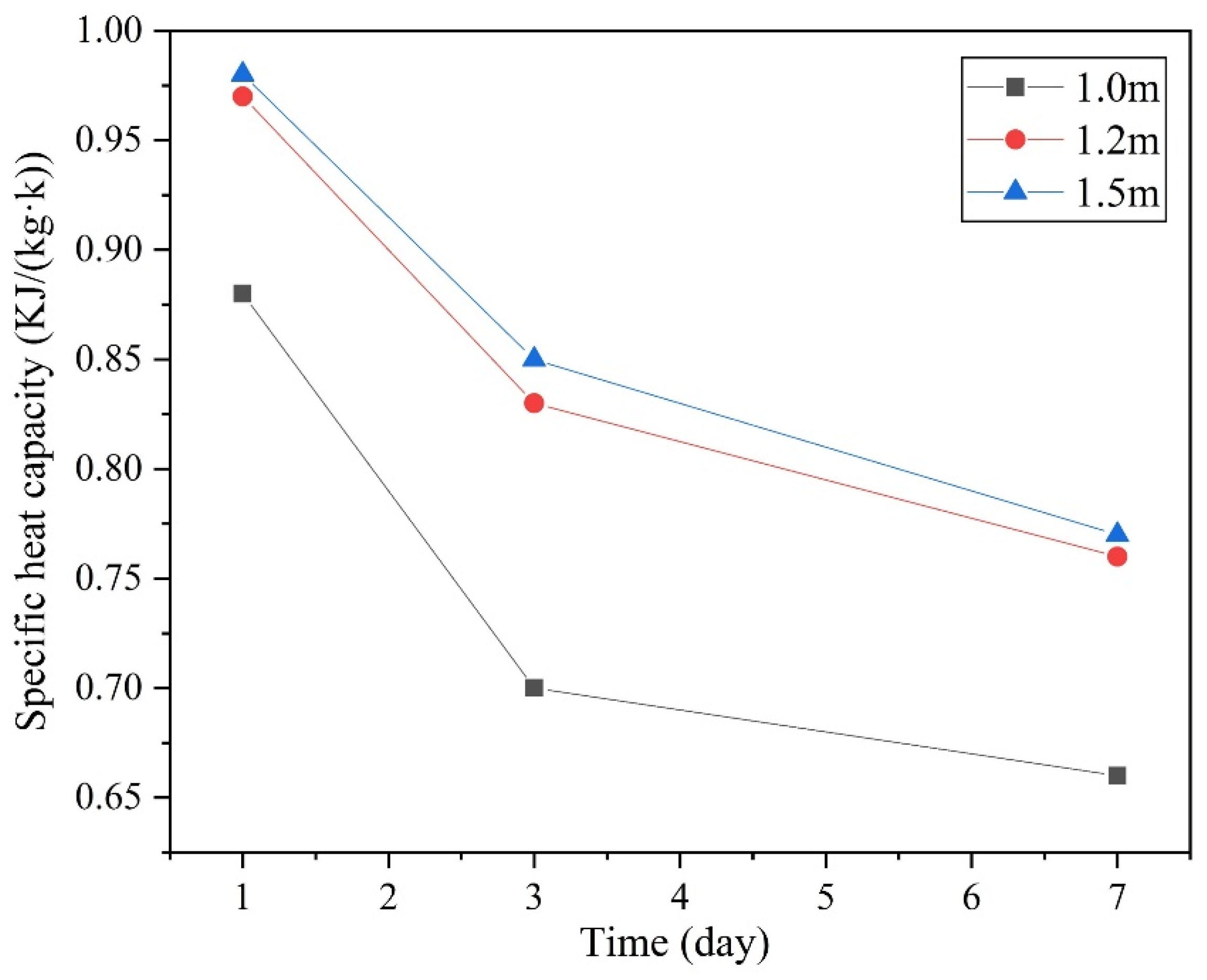
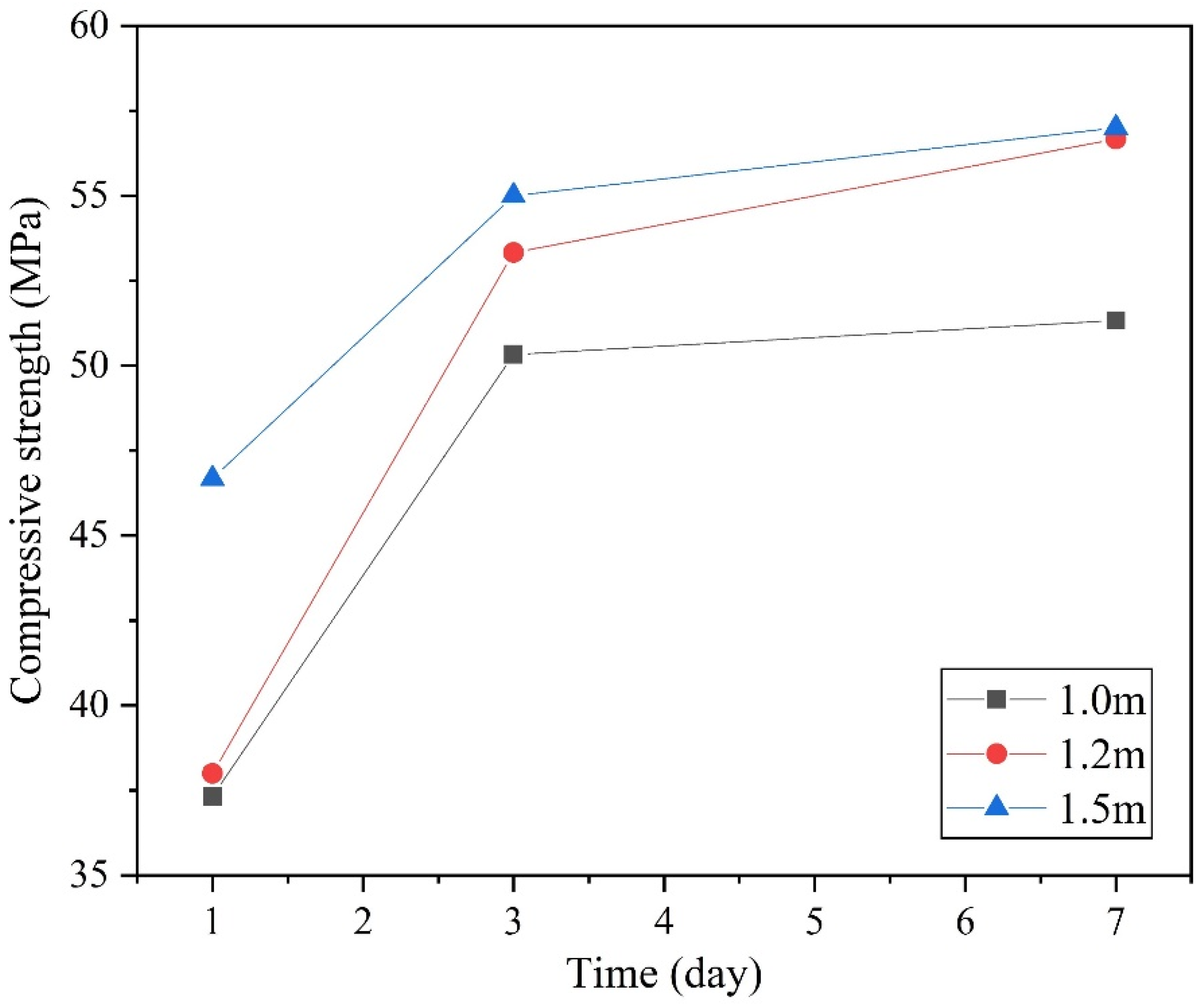
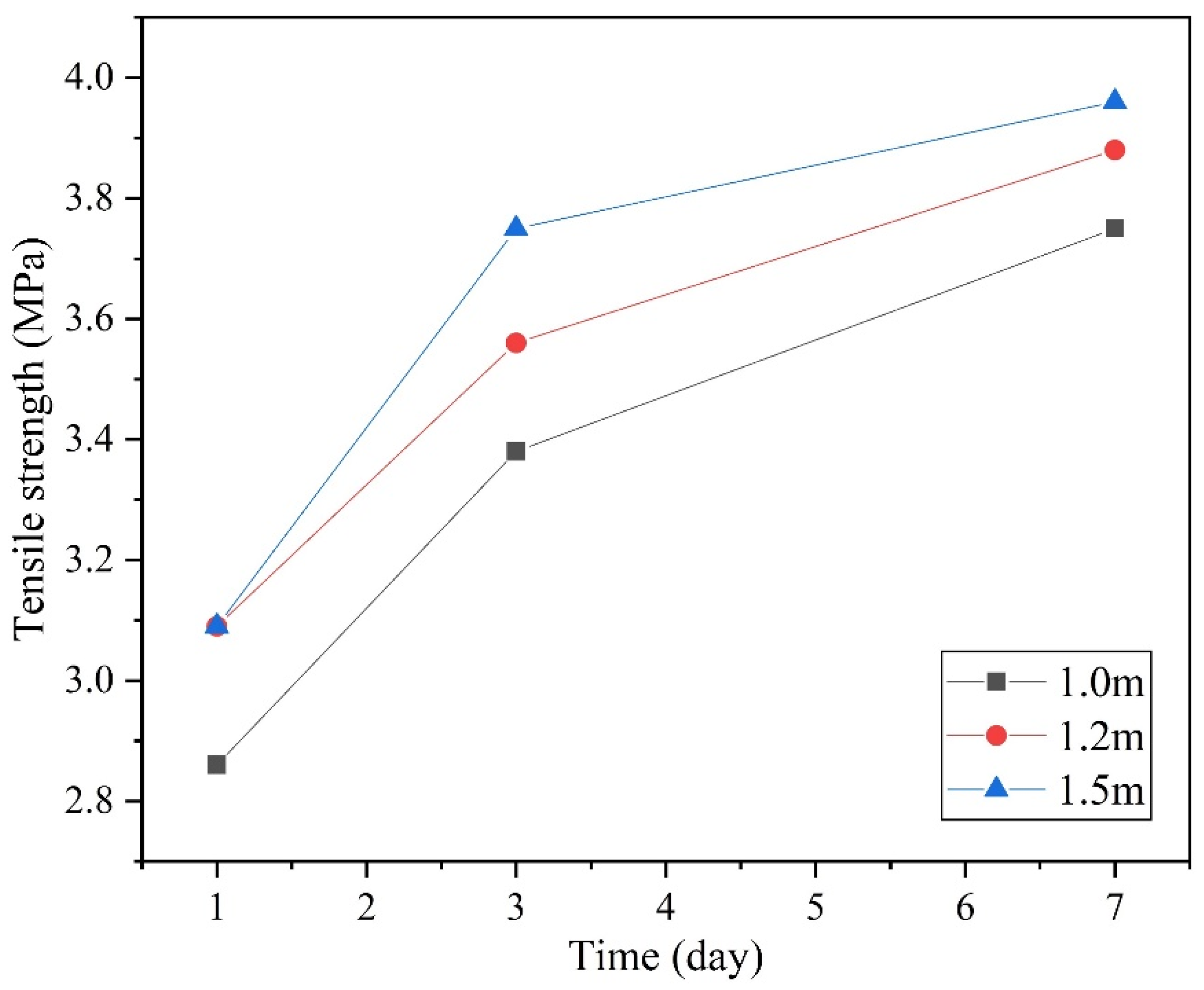
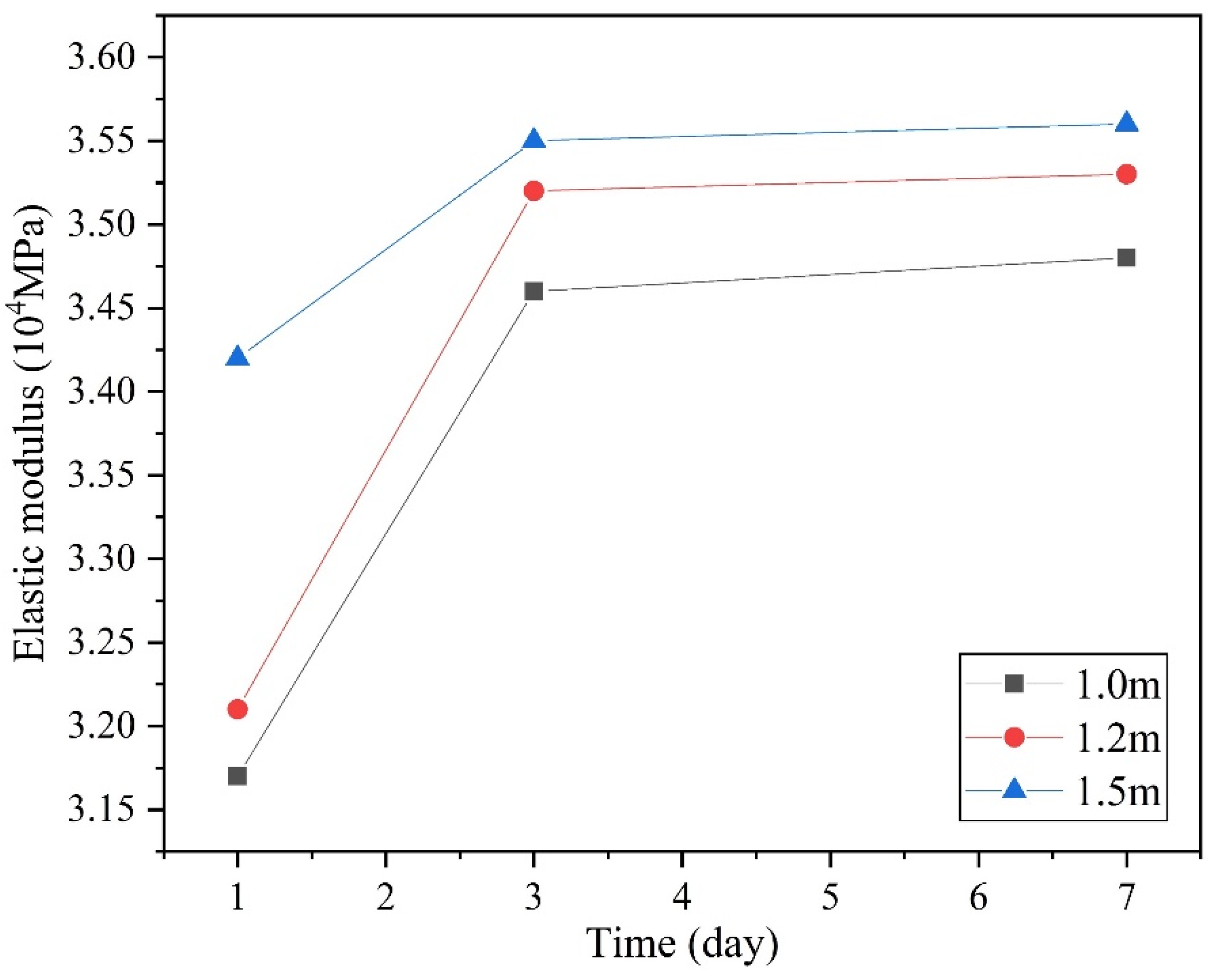
| Concrete Grade | Cement (kg) | Sand (kg) | Sand Ratio (%) | Water Reducing Agent (%) | Water Cement Ratio(-) |
|---|---|---|---|---|---|
| C60 | 460 | 800 | 38 | 0.60 | 0.34 |
| Number | Thermal Conductivity (W/(m·k)) | Time (d) | Thickness (m) | Fitting Equation | R-Squared |
|---|---|---|---|---|---|
| 1 | y | x | 1.0 | 1 | |
| 2 | y | x | 1.2 | 1 | |
| 3 | y | x | 1.5 | 1 |
| Number | Specific Heat Capacity (KJ/(kg·k)) | Time (d) | Thickness (m) | Fitting Equation | R-Squared |
|---|---|---|---|---|---|
| 1 | y | x | 1.0 | 1 | |
| 2 | y | x | 1.2 | 1 | |
| 3 | y | x | 1.5 | 1 |
| Number | Compressive Strength (MPa) | Time (d) | Thickness (m) | Fitting Equation | R-Squared |
|---|---|---|---|---|---|
| 1 | y | x | 1.0 | 1 | |
| 2 | y | x | 1.2 | 1 | |
| 3 | y | x | 1.5 | 1 |
| Number | Tensile Strength (MPa) | Time (d) | Thickness (m) | Fitting Equation | R-Squared |
|---|---|---|---|---|---|
| 1 | y | x | 1.0 | 1 | |
| 2 | y | x | 1.2 | 1 | |
| 3 | y | x | 1.5 | 1 |
| Number | Elastic Modulus (104 MPa) | Time (d) | Thickness (m) | Fitting Equation | R-Squared |
|---|---|---|---|---|---|
| 1 | y | x | 1.0 | 1 | |
| 2 | y | x | 1.2 | 1 | |
| 3 | y | x | 1.5 | 1 |
Publisher’s Note: MDPI stays neutral with regard to jurisdictional claims in published maps and institutional affiliations. |
© 2022 by the authors. Licensee MDPI, Basel, Switzerland. This article is an open access article distributed under the terms and conditions of the Creative Commons Attribution (CC BY) license (https://creativecommons.org/licenses/by/4.0/).
Share and Cite
Zhang, C.; Zhang, Y.; Yang, W.; Yin, J.; Zhang, T. Study on Evolution of the Thermophysical and Mechanical Properties of Inner Shaft Lining Concrete during Construction Period. Appl. Sci. 2022, 12, 10141. https://doi.org/10.3390/app121910141
Zhang C, Zhang Y, Yang W, Yin J, Zhang T. Study on Evolution of the Thermophysical and Mechanical Properties of Inner Shaft Lining Concrete during Construction Period. Applied Sciences. 2022; 12(19):10141. https://doi.org/10.3390/app121910141
Chicago/Turabian StyleZhang, Chi, Yu Zhang, Weihao Yang, Jiying Yin, and Tao Zhang. 2022. "Study on Evolution of the Thermophysical and Mechanical Properties of Inner Shaft Lining Concrete during Construction Period" Applied Sciences 12, no. 19: 10141. https://doi.org/10.3390/app121910141





